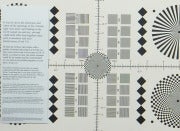The Fujifilm FinePix F550EXR sits at number 6 on our Top 10 Pocket Megazooms chart,
and it got there by virtue of its high-end features: high-speed video
and burst modes, RAW and JPEG shots, GPS functionality, and more.
The 16-megapixel, 15X-optical-zoom Fujifilm FinePix F550 EXR
($350 as of 9/7/2011) is the latest model in Fujifilm’s higher-end F
series, and it’s appropriately packed with features. In addition to
manual, semimanual, and automatic shooting modes, the F550 is one of the
latest crew of cameras with GPS capabilities and a long-zoom lens. The
F550 fits neatly into the pocket megazoom category
of cameras, offering some far-reaching in-camera goodies that will
interest snapshooters, photo enthusiasts, and vacationers alike.
The F550’s arsenal includes full HD video with stereo sound and
autofocus, slow-motion video, multiple bracketing modes, film-simulation
options, user-selectable dynamic range, and other appealing features. A
trio of EXR modes are geared toward improving image quality in
different conditions, and the camera can also capture 360-degree
panoramas in one fell swoop.
The geotagging-friendly F550 stands apart from its twin, the F500,
with one of the best GPS implementations of any camera on the market
today. The F550 adds GPS to the F500’s feature set for an additional $20
or so, and it’s well worth the extra cost, even for a once- or
twice-a-year vacation. The F550 also offers RAW and RAW + JPEG; the F500
does not.
While the F550 has the in-camera features to go toe-to-toe with
most long-zoom pocket cameras, image quality may not be on a par with
the competition. However, for many users, the F550 has more than enough
strengths to compensate for its photo- and video-quality shortcomings.
Hardware and Design
 The
Fujifilm FinePix F550 EXR is built around a new EXR-branded
backside-illuminated CMOS sensor. Like past Fujifilm EXR cameras, the
in-camera menus let you select between three special EXR modes that
tweak the sensor’s settings to improve image resolution, low-light
performance, and dynamic range.
The
Fujifilm FinePix F550 EXR is built around a new EXR-branded
backside-illuminated CMOS sensor. Like past Fujifilm EXR cameras, the
in-camera menus let you select between three special EXR modes that
tweak the sensor’s settings to improve image resolution, low-light
performance, and dynamic range.
Equipped with a stabilized 15X-optical-zoom lens, the F550’s focal
range starts at a highly useful 24mm and extends to a long-reaching
360mm. With this kind of lens versatility, the F550 is capable of
handling everything from broad vistas to distant subjects. The F550’s
multiple image stabilization feature is a combination of sensor-shift
(mechanical), high ISO (electronic), and an "Advanced Anti-Blur" that
shoots and merges four shots to help eliminate blur and image noise
(essentially a bracketing mode). Like practically every pocket megazoom
we’ve reviewed, the lens isn’t particularly fast: Maximum aperture
settings range from F3.5 wide-angle to F5.3 telephoto.
Available in black or glossy red, the F550 is sleek looking and
solidly built. The body measures 4.1 inches wide, 2.5 inches tall, and
1.3 inches deep. It won’t slide into tight jeans’ pockets, but it’s
compact enough to fit comfortably into more generously cut clothing. It
weighs about 7.6 ounces fully loaded.
The tiny grip and rubberized pad should provide a relatively
comfortable handhold for most shooters, but if your hands resemble
catcher’s mitts, try the camera on for size before you buy it. Controls
and dials are relatively small, but they’re generally well-positioned
for easy access.
The F550’s shutter/zoom-control combo sits along the top edge, as
does the tiny on/off button. The GPS antenna is nicely integrated into
the design--it’s fairly low-profile. To the left of the GPS unit is the
pop-up flash, which automatically goes up when the camera powers on;
it’s easy to press back into a closed position when not in use.
 A small mode dial
is angled between the top surface and the rear panel, in perfect
position to thumb through the various modes. Unfortunately, our review
unit’s mode dial was extremely stiff, and it took more effort than usual
to move from one mode to another.
A small mode dial
is angled between the top surface and the rear panel, in perfect
position to thumb through the various modes. Unfortunately, our review
unit’s mode dial was extremely stiff, and it took more effort than usual
to move from one mode to another.
Other controls include a dedicated
movie button, playback, display, and "F" function buttons. The latter
displays a quick menu to change common settings such as ISO and image
size, while a four-way keypad doubles as one-touch access to the macro,
exposure compensation, flash settings and self-timer. A small command
dial surrounds the four-way controller and has just enough tension to
keep it from moving too freely. A center menu button calls up the main
menu for access to the remainder of the F550’s options.
The 3-inch LCD works well under most conditions, even though its
460,000-dot resolution is only average these days. It’s certainly bright
enough to easily read menus and review images during playback.
A single media card slot accommodates SD/SDHC/SDXC cards. It has
39MB of internal memory as well, but that doesn’t make much of a
difference since it holds maybe five high-res images. If you want to
view your images and video on an HDTV, a mini-HDMI port is under a door
on the side of the camera.
Shooting Modes and Features
The F550’s core shooting modes include Auto, Program, shutter
priority, aperture priority, and full manual mode. As expected, there
are a number of scene modes, including the standard portrait, landscape,
sport, night, sunset, beach, and the like. A special underwater mode is
available for shooting with the camera’s separately sold underwater
housing (the camera also has an underwater white balance option). In a
unique Pets mode, used in conjunction with the auto-release self-timer
option, the camera automatically takes a shot when it detects a pet.
Like most cameras’ face-detection modes, though, the pet has to be
facing the camera--which is sometimes easier said than done.
The final two options on the mode dial--Advanced Mode and EXR--are
reason enough to reference the user guide. Advanced Mode offers three
options: Motion Panorama 360, Pro Focus, and Pro Low Light. Motion
Panorama 360 is easy to use once you get the hang of how to pace
sweeping the camera across a scene, and it works quite well.
Another useful feature is the "Pro Focus" mode, which captures
multiple shots, producing a soft background while keeping the main
subject in focus. The amount of focus is user-adjustable and works best
for portraits and macro shots. In "Pro Low Light" mode, the camera
captures four exposures and merges them into a single photo to help
prevent blur and image noise. This is probably the weakest of the three
advanced modes, as its success depends greatly on the shooting
conditions.
The EXR modes start off with Auto EXR, in which the camera
analyzes the conditions and selects the most appropriate scene mode.
Other choices include Resolution Priority (for the cleanest, sharpest
images), High ISO/Low Noise, and Dynamic Range (which can be adjusted).
The latter two cut the resolution to 8 megapixels, but that might be
worthwhile, as both modes work well.
Continuous shooting is peppy: 8 frames per second at full
resolution, and the buffer tops out at 8 photos. Higher speed capture of
11 fps up to 16 frames is possible at 8 megapixels; at a 4-megapixel
resolution, the F550 can capture up to 32 frames at 11 fps. Shot-to-shot
time was nice and quick for JPEGs, but you may have to wait up to 4-5
seconds for the beefier images to save when shooting RAW.
Video options range from 1080p full HD at 30 fps to silent movies
shot at 320 fps at 320-by-112 resolution. There are also a number of
video settings in between. From 1080p to 640-by-480 VGA at 30 fps, the
camera records stereo sound. The slow-motion movies are fun but, as with
similar slow-motion options, the footage is tiny and best viewed on a
computer screen. Center or continuous autofocus are both available in
movie mode; the zoom is also operational, albeit with slower zooming to
cut down on noise.
The F550 offers a number of other attractive options including a
search function, which can locate images by parameters such as the scene
mode used and the location in which you shot them. Overall, the camera
is fairly easy to operate, but some of its options are best understood
by reading the user guide.
GPS Features
The GPS capabilities are one of the major highlights of the F550, as
they’re more extensive and useful than your average “add geolocation
data to EXIF” feature. Reading the user guide is especially helpful
here, as there are a number of geotagging options.
The GPS can be set up to show just latitude and longitude, but
also has an option to use an embedded database to apply real-world
location names within the camera. When you're playing back images, the
camera can also calculate how far you are from the place the image was
taken. On the desktop side of the equation, you can use the included,
Windows-only MyFinePix Studio in conjunction with Google Maps to see the
route you traveled.
All in all, the F550's in-camera GPS options run circles around those we've seen in most models, except for one: the Casio Exilim EX-H20G,
which has in-camera mapping and some similar location-name and
distance-calculating features. The F550 is the closest we've seen to
matching it, however.
Of course, if the GPS is left on all the time--even when the
camera is turned off--it will drain the battery. The better option is to
have the camera search for a satellite signal each time you power it
on; it can take a minute or two, but the battery will last longer.
Performance, Image Quality and Video Quality


 In
PCWorld Labs’ subjective tests for image quality, the FinePix F550EXR
fared well, but its overall imaging score trailed competing pocket
megazooms such as the Nikon Coolpix S9100 and Canon PowerShot SX230 HS.
Lack of image distortion was a notably strong suit given its 15X zoom
lens, as the F550 earned a score of Very Good in that category--the best
among competitors. Image sharpness was also rated as Good, besting the
Coolpix S9100 in our tests. However, it lagged a bit behind the
competition in color accuracy and exposure quality, although it did earn
scores of Good in those categories.
In
PCWorld Labs’ subjective tests for image quality, the FinePix F550EXR
fared well, but its overall imaging score trailed competing pocket
megazooms such as the Nikon Coolpix S9100 and Canon PowerShot SX230 HS.
Lack of image distortion was a notably strong suit given its 15X zoom
lens, as the F550 earned a score of Very Good in that category--the best
among competitors. Image sharpness was also rated as Good, besting the
Coolpix S9100 in our tests. However, it lagged a bit behind the
competition in color accuracy and exposure quality, although it did earn
scores of Good in those categories.
In my hands-on tests, I also found image quality to be
hit-or-miss. JPEG images straight out of the camera looked a little
soft, and image noise was visible in shadows even at low ISOs. On the
other hand, some night-time test shots at higher ISOs looked
surprisingly good. Colors are generally rendered naturally, and exposure
is accurate more often than not. Kept at reasonable sizes (8 by 10 and
below), prints from the camera look quite good.
The camera is also fairly responsive. Given enough light and
contrast, autofocus is fast and accurate. The zoom moves smoothly
through its 15X range, and the sensor-shift image stabilization works
well. However, in low light, it’s best to use a tripod for telephoto
shots.
You can view the full-size images used for PCWorld Labs’ testing by clicking on the thumbnail images at left.
With video, the FinePix F550 wasn’t as competitive. The camera
earned a video quality score of Good in PCWorld Labs’ subjective tests,
but its aggregate video score was noticeably lower than that of the
Coolpix and PowerShot cameras mentioned above, and was little more than
half the score of the video-friendly Sony Cyber-shot HX9V.
The FinePix F550’s video quality is noticeably inferior in low-light
situations, with a bluish tint and murky contrast in our test footage.
In our low-light test, you couldn't see much of anything. Audio pickup
is decent--if a bit tinny sounding--out of the camera’s stereo
microphones, and its audio capture earned a score of Good.
You can view the test clips used for our subjective video tests
below. Select 1080p from the drop-down menu in each player for the
highest-quality footage.
Buying Advice
The Fujifilm FinePix’s F550 feature set varies from the pocket megazoom norm, and that’s largely a good thing. You don’t have to understand how some of the special features, such as the EXR modes, work; you only have to figure out how and when to use them. The F550’s GPS features are also among the best we’ve seen in a camera yet, as they take GPS further than just longitudinal and latitudinal EXIF data.With so many features, the F550 is priced right for snapshooters and enthusiasts. You may have to compromise a bit on image and video quality compared to long-zoom compact cameras such as the Nikon Coolpix P9100, the Sony Cyber-shot DSC-HX9V, and the Canon PowerShot SX230 HS, but the Fujifilm FinePix F550’s feature set gives them a run for the money.








0 comments:
Post a Comment